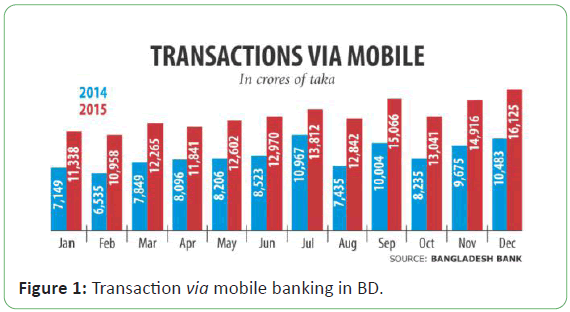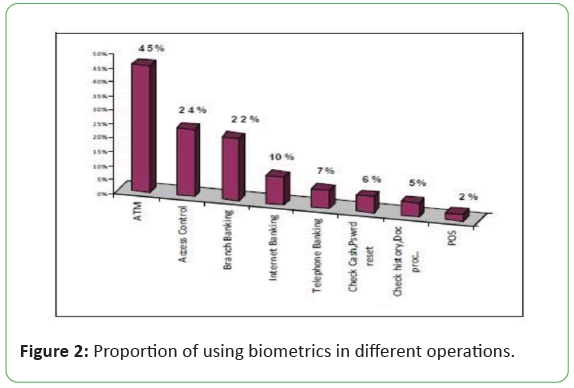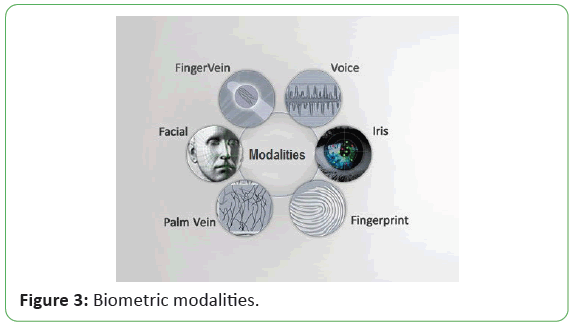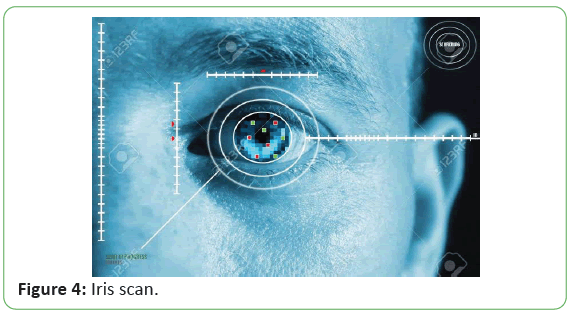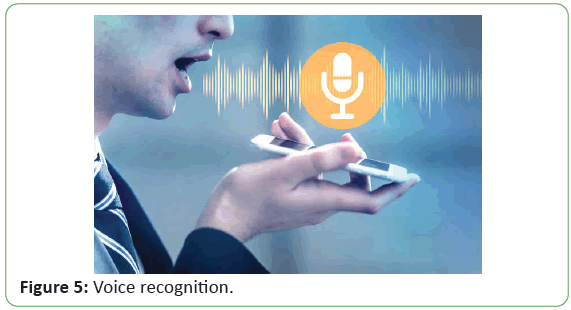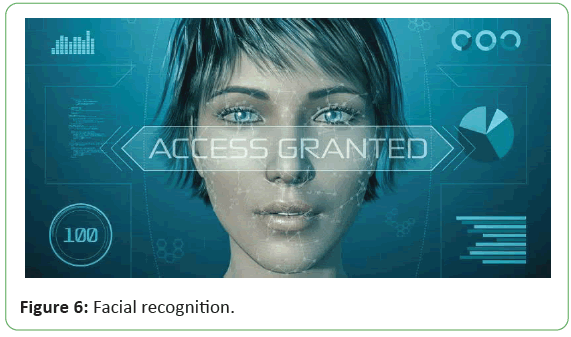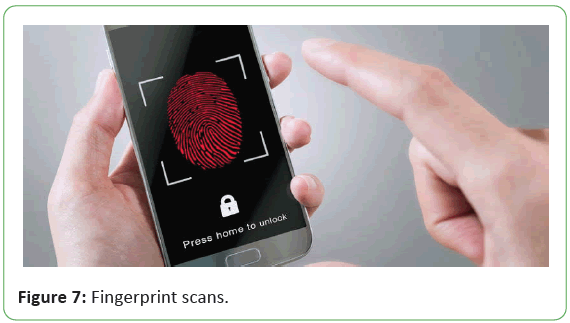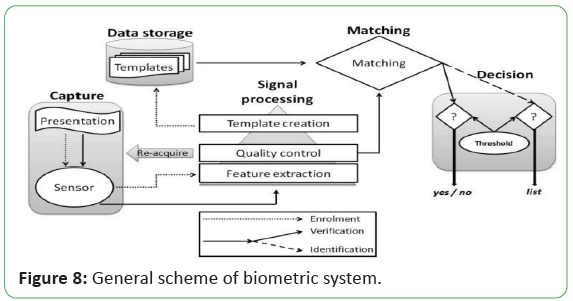Keywords
Biometric; Quantitative analysis; Authentication; Mobile banking
Introduction
Mobile banking is a service provided by a financial institution
that allows customers to conduct financial transactions, such as
electronic bill payments and funds transfers, using a mobile device
and software provided by the aforementioned institution. While
mobile banking has its upsides, security of financial transactions is
a very important issue that needs to be addressed very carefully,
as online banking is one of the most sensitive tasks performed by
general user [1]. Although many traditional banks offer mobile
baking with peace of mind [2], one should note that there is not a
silver bullet providing a user with 100% security guarantee. Mobile
banking in Bangladesh continues to grow fast, scaling a new
height last year with 53 percent growth year-on-year. In 2015, the
industry saw Tk 157,773.31 crore in transactions through mobile
phones, the amount being more than half the country's national
budget, according to a report of Bangladesh Bank. In 2014, the
mobile banking industry saw Tk 103,155.37 crore in transactions.
People are becoming increasingly comfortable with the banking
platform, analysts said. The average monthly transactions made
through mobile phones stood at more than Tk 13,147.77 crore
last year, rising from Tk 8,596.28 crore in 2014 [3]. Transaction via
Mobile Banking in BD is shown in Figure 1.
Figure 1: Transaction via mobile banking in BD.
There is no doubt that mobile banking has proven to be most
convenient way of using banking services. But, along with various
benefits, mobile banking exposes itself to various types of security risks. Major concern for mobile banking is to prevent unauthorized
access. Considering the increasing number of financial frauds, a
reliable authentication system must be incorporated. Biometric
systems are known to be most reliable authentication systems,
because they have the potential to solve many security problems.
“Biometrics” is defined as “the automated means of recognizing
a living person through the measurement of distinguishing
physiological or behavioral traits” [4]. Biometrics is widely used
across various fields like forensics, ATMs, incellular phones, smart
cards, PCs, in workplaces, and computer networks. But apart from
its wide usage it is still not implemented in mobile banking. Figure
2 shows proportion of using biometrics in different operations.
Figure 2: Proportion of using biometrics in different operations.
Authentication Schemes in Mobile
Banking
In mobile banking, there are mainly two types of authentication
schemes used i.e. single factor authentication and multi factor
authentication [5].
Single factor authentication
Single factor authentication refers to the use of authentication
credentials i.e., user name and password. Disadvantage of this
scheme is that the passwords can easily be guessed and stolen by
using different algorithms [5].
Multi factor authentication
Multi factor authentication makes the use of mainly two different
factors i.e. something you have and something you know. It
involves combination of two factors i.e., static passwords and
one-time passwords generated by small devices. Although
this scheme provides higher level of security than single factor
authentication, but it is not reliable. There is always a risk of
unauthorized access to mobile devices so the OTPs can be easily
stolen [6].
Considering the shortcomings of single factor and multi factor
authentication schemes, it is concluded that more reliable
authentication mechanism must be incorporated in mobile
banking. In this context an analysis of various biometric
techniques is required so that best of them can be used for the
authentication system.
An Overview of Biometric Modalities
Figure 3 shows Biometric Modalities. Biometric identification
methods can be achieved on mobile devices either through its
built-in biometric sensors, attaching portable biometric hardware
to it via a USB cable, or through a Wi-Fi connection. Here are a
few biometric authentication methods that banks are already
taking advantage of:
Figure 3: Biometric modalities.
Iris scan
Iris scanning biometrics measures the unique patterns in the
colored circle of your eye to verify and authenticate your identity.
Contactless, fast and renowned for its accuracy, biometric iris
recognition can operate at long distances, with some solutions
that leverage the modality requiring only a glance from a user [7].
This mode contains more than 200 unique points of data that
are stored in the institution’s database. Many biometric experts
believe that the iris scan is the most reliable way of authenticating
a user’s identity (Figure 4) [8].
Voice recognition
In this method, voice signals are converted into electrical signals
and then compared with database. These systems operate with
user’s knowledge. However, wrong voices cannot always be
avoided. Biggest drawback of this scheme is that the system may
be hacked with prerecorded voice messages (Figure 5) [9].
Figure 5: Voice recognition.
Facial recognition
Facial recognition can authenticate users at ATMs, as well as online
and mobile banking. This type of authentication is dependent on
the user’s environment such as the lighting or positioning of the
face, making it a less effective security option [8].
It has a relatively low cost (i.e., it can be carried out using standard
cameras) and is one of the least intrusive biometric modalities
available, since it does not require physical contact like fingerprint
recognition or retina scanning (Figure 6) [10].
Figure 6: Facial recognition.
Fingerprint scans
Fingerprint scans are currently the most popular form of biometric
authentication used on many mobile devices worldwide [8].
The use of fingerprints for identification has been employed in
law enforcement for about a century. A much broader application
of fingerprints is for personal authentication, for instance to
access a computer, a network, a bank-machine, a car, or a home
(Figure 7) [11].
Figure 7: Fingerprint scans.
Vein pattern authentication
Vein pattern authentication relies on the unique pattern of veins
in the palm, finger, or eye to identify a user. The vein patterns of
the user are as unique as their fingerprints, but not as easy to
replicate [12].
Finger vein patterns are unique biometric features, which
differentiate from individual to individual, so they are suitable
for authentication applications. Systems based on the use of this feature have numerous advantages such as low cost and high
accuracy.
General Scheme of a Biometric System
There are three main functionalities of a biometric authentication
process which are given below [13]:
Enrollment
Process of acquiring, accessing and storing data in the form of
template for later use is called enrollment.
Verification
Verification is the process of matching between stored template
and biometric. Matching score is provided between 0 and 100%.
Although no system ever reaches to 100%.
Identification
Process of identifying an individual from a number of database
values is called identification. Access may be granted to user or
the user can also be rejected.
General scheme of biometric system is shown in Figure 8 [14].
Figure 8: General scheme of biometric system.
Comparison of Biometric Techniques
Based on their Properties
Biometric techniques are mostly characterized by seven
properties [14,15]. These properties have been used as criteria
for comparison.
• Universality: Every individual must have this property.
• Uniqueness: It should be distinct for two different individuals.
• Permanency: it should be preserved for lifetime of an individual.
• Collectability: it should be easily measured.
• Acceptability: it measures the use of a particular biometric
system by users.
• Performance: it indicates the achievable accuracy, speed and
robustness of the biometric property.
• Circumvention: it relates to ease with which a biometric system
can be circumvented or bypassed. Table 1 shows the comparison
of various biometric techniques based on seven criteria [16,17].
| Biometric technique |
Universality |
Uniqueness |
Performance |
Collectability |
Acceptability |
Resistance to
Circumvention |
Permanency |
Total |
| Finger print |
2 |
3 |
3 |
2 |
2 |
3 |
2 |
17 |
| Face |
3 |
1 |
2 |
2 |
3 |
1 |
2 |
14 |
| Iris |
3 |
3 |
3 |
2 |
1 |
1 |
3 |
16 |
| Signature |
1 |
1 |
1 |
3 |
3 |
3 |
1 |
13 |
| Voice |
2 |
1 |
1 |
2 |
3 |
3 |
1 |
13 |
| Hand Vein |
2 |
2 |
2 |
2 |
2 |
1 |
2 |
13 |
Table 1: Comparison of various biometric techniques based on seven criteria.
Discussion
Table 1 refers to the comparison between six biometric
techniques i.e., Fingerprint recognition, Face recognition, Iris
Recognition, Signature recognition and hand vein recognition.
Comparison is based on seven criteria which are characterized
by three levels i.e., Low, Medium and High [14,18]. In order to
do quantitative analysis, numerical values have been assigned to
these three levels i.e., 1 refers to low level, 2 to medium level and
3 to high level.
In this study, six biometric techniques which are more applicable
to mobile banking have been chosen for analysis. Table 2 refers
to ranking of biometric techniques. Based on total values of
seven indicators, Fingerprint recognition is the highest-ranking
biometric feature, Iris recognition is second and Face recognition
is placed on third rank which is followed by Signature, Voice
and Hand vein recognition. Biometric systems require hardware
implementation for proper functioning of the system. Fingerprint,
Iris and face recognition require scanners for recognition. Since
most mobile phones are equipped with these scanners nowadays
days so it will be easier for banks to include biometric features in
financial transactions. In order to achieve higher level of security,
biometric systems can be combined with passwords.
| Sr. No |
Biometric |
Total value |
| 1 |
Fingerprint |
17 |
| 2 |
Iris |
16 |
| 3 |
Face |
14 |
| 4 |
Signature |
13 |
| 5 |
Voice |
13 |
| 6 |
Hand Vein |
13 |
Table 2: Ranking of biometric techniques.
Conclusion
Since traditional authentication methods used in mobile banking
such as passwords, tokens etc. do not assure high level of security,
it is clear that use of biometric system is imperative for security in
mobile banking. This paper presents overall quantitative analysis
of various biometric techniques so that appropriate technique
can be incorporated in mobile banking. From above analysis, it
has been inferred that Fingerprint recognition is best among six
biometric techniques used for comparison. Future work will focus
on studying and analyzing more important features other than
above mentioned. Another scope for future work is to analyze
various problems and security risks involved with Biometric
systems.
References
- Mannan M, Van Oorschot PC (2008) Security and usability: The gap in real-world online banking. In Proceedings of the 2007 Workshop on New Security Paradigms: 1-14.
- Lee YS, Kim NH, Lim H, Jo H, Lee HJ (2010) Online banking authentication system using mobile-OTP with QR-code. In 5th Int Conf Comput Sci Converg Info Tech: 644-8.
- The Daily Star. The dailystar. 2014.
- Kaur S (2017) Security in mobile banking: A biometric approach. Int J Eng Sci Manag Res 4: 93-8.
- Parusheva S (2015) A comparative study on the application of biometric technologies for authentication in online banking. Egypt Comput Sci J 39: 116-27.
- Hayikader S, Binti Abd Hadi FH, Ibrahim J (2016) Issues and security measures of mobile banking Apps. Int J Sci Res Publ 6: 36-41.
- Biometrics. findbiometrics. 2020.
- How biometric authentication is shaping the future of security in mobile banking. 2019.
- Bhatia R (2013) Biometrics and face recognition techniques. Int J Adv Res Comput Sci Softw Eng 3: 93-9.
- Soldera J, Schu G, Schardosim LR, Beltrao ET (2017) Facial biometrics and applications. IEEE Instru Meas Mag 20:4-30.
- O’Gorman L (1998) Fingerprint Verification. Biometrics 3: 43-64.
- Tagkalakis F, Vlachakis D, Megalooikonomou V, Skodras A (2017) A novel approach to finger vein authentication. In 2017 IEEE 14th International Symposium on Biomedical Imaging: 659-62.
- El-Abed M, Giot R, Hemery B, Rosenberger C (2012) Evaluation of biometric systems: A study of users’ acceptance and satisfaction. Int J Biom 4: 265-90.
- Stavroulakis P, Stamp M, editors (2010) Handbook of information and communication security. Springer Science & Business Media; 2010: 139.
- Sharma K, Singh AJ (2012) Biometric Security in the E-world. In Cyber Crime: Concepts, Methodologies, Tools and Applications. IGI Global: 474-523.
- Saini H, Garg K (2013) Comparative analysis of various biometric techniques for database security. Int J Sci Res 2: 45-51.
- The best and most practical biometric modalities for individual identification. The Cloud Biometric Company. 2016.
- Hosseini SS, Mohammadi S (2012) Review banking on biometric in the world’s banks and introducing a biometric model for Iran’s banking system. Int J Sci Basic Appl Res 2: 9152-60.

